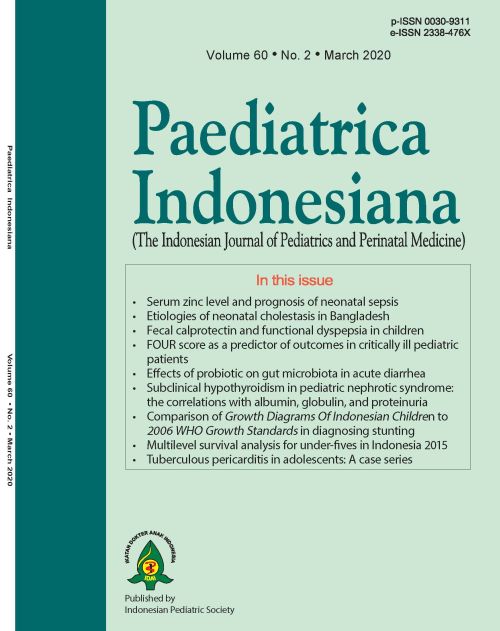Serum zinc level and prognosis of neonatal sepsis
DOI:
https://doi.org/10.14238/pi60.2.2020.61-66Keywords:
serum zinc levels; neonatal sepsis; prognosis; early-onset neonatal sepsisAbstract
Background The prognosis of neonatal sepsis can be influenced by various risk factors, one of which is a deficiency of zinc micronutrient substances.
Objective To assess for a potential association between serum zinc level and prognosis of infants with early-onset neonatal sepsis (EONS).
Methods This prospective cohort study was done in neonates with clinical EONS from September 2017 until December 2018. Serum zinc level was measured on the first day of diagnosis and prognosis was assessed on the fourth day. The association between serum zinc levels and prognosis of EONS was analyzed by Chi-square test and logistic regression with adjustment for confounding variables.
Results A total of 70 subjects were divided into two groups based on their serum zinc levels. A cut-off point of 75 ug/dL was used based on area under the curve (sensitivity 91.2% and specificity 93.7%), with accuracy 97.8% (95%CI 0.943 to 1.000; P=0.0001). Subjects with lowzinc level had a 16.8 times greater risk compared to subjects with high serum zinc (RR=16.81; 95% CI 4.35 to 65.02; P <0.0001). Multivariate analysis revealed that subjects with low serum zinc levels had 203.7 times greater risk of worsening than subjects who had a higher serum zinc level (RR 203.72; 95% CI 26.79 to 1549.17; P <0.0001). Covariates such as male sex, low gestational age (<37 weeks), low birth weight (<2,500 grams), asphyxia, Caesarean section delivery, and the presence of comorbidities did not have significant associations with outcomes of EONS (P >0.05).
Conclusion Serum zinc level is associated with prognosis of early onset neonatal sepsis, with a cut-off of 75 μg/dL. The high level of serum zinc associates with a better prognosis.
References
2. Junara PJ. Insiden dan faktor-faktor yang berhubungan dengan sepsis neonatus di RSUP Sanglah Denpasar. Sari Pediatri. 2012;14:205-10. DOI: 10.14238/sp14.3.2012.205-10.
3. Gotoff SP. Infection of the neonatal infant. In: Behrman RE, Kliegman RM, Jerrion HB (eds). Nelson’s textbook of pediatrics. 16th ed. Philadelphia: WB Saunders Company; 2000. p. 538-52.
4. Jain NK, Jain VM. Neonatal sepsis. In: Maheswari, ed. The neonate - a practical manual of common newborn problems. New Delhi: Aditya Med Publ; 2003. p. 80-4.
5. Aminullah A. Sepsis pada bayi baru lahir. In: Kosim MS, Yunanto A, Dewi R, Sarosa GI, Usman A, editors. Buku Ajar Neonatologi. 1st ed. Jakarta: Badan Penerbit IDAI; 2010. p. 170-87.
6. Dijkhuizen MA, Wieringa FT. Vitamin A, iron and zinc deficiency in Indonesia [dissertation]. Wageningen: Wageningen University; 2001.
7. Armin SA. Zat gizi mikro zink, dari aspek molekuler sampai pada program kesehatan masyarakat. Suplement. 2005;26:29-34.
8. Saner G, Baysal SU, Unuvar E, Ozden T. Serum zinc, copper levels and copper/ zinc ratios in infants with sepsis syndrome. J Trace Elem Exp Med. 2000;13:265-70.
9. Brown KH. Effect of infections on plasma zinc concentration and implications for zinc status assessment in low-income countries. Am J Clin Nutr. 1998;68:425-9. DOI: 10.1093/ajcn/68.2.425S.
10. Costelo AM, Osrin D. Micronutrient status during pregnancy and outcomes for newborn infants in developing countries. J Nutr. 2003;133:1757S-65S. DOI: 10.1093/jn/133.5.1757S.
11. Hapsari AT. Kadar seng serum sebagai indikator prognosis pada keluaran sepsis neonatorum [dissertation]. Semarang: Ilmu Kesehatan Anak Fakultas Kedokteran Universitas Diponegoro; 2009.
12. Hambidge M. Human zinc deficiency. J Nutr. 2000;130:1344-9. DOI: 10.1093/jn/130.5.1344S.
13. Winieswska M, Cremer M, Wiyhe L, Becker N, Rjintes E. Copper to zinc ratio as disease biomarker in neonates with early-onset congenital infections. Nutrients. 2017;9:343-57. DOI: 10.3390/nu9040343.
14. Visalakshy J, Surendran S, Pillai MP, Rajendran A, et al. Could plasma zinc be a predictor for mortality and severity in sepsis syndrome? Int J Res Med Sci. 2017;5:3929-34. DOI: 10.18203/2320-6012.ijrms20173956.
15. Tang Z, Wei Z, Wen F, Wu Y. Efficacy of zinc supplementation for neonatal sepsis: a systematic review and meta-analysis. J Maternal Fetal Neonatal Med. 2019;32:1213-8. DOI: 10.1080/14767058.2017.1402001.
Downloads
Published
How to Cite
Issue
Section
License
Authors who publish with this journal agree to the following terms:
Authors retain copyright and grant the journal right of first publication with the work simultaneously licensed under a Creative Commons Attribution License that allows others to share the work with an acknowledgement of the work's authorship and initial publication in this journal.
Authors are able to enter into separate, additional contractual arrangements for the non-exclusive distribution of the journal's published version of the work (e.g., post it to an institutional repository or publish it in a book), with an acknowledgement of its initial publication in this journal.
Accepted 2020-02-18
Published 2020-02-18


















